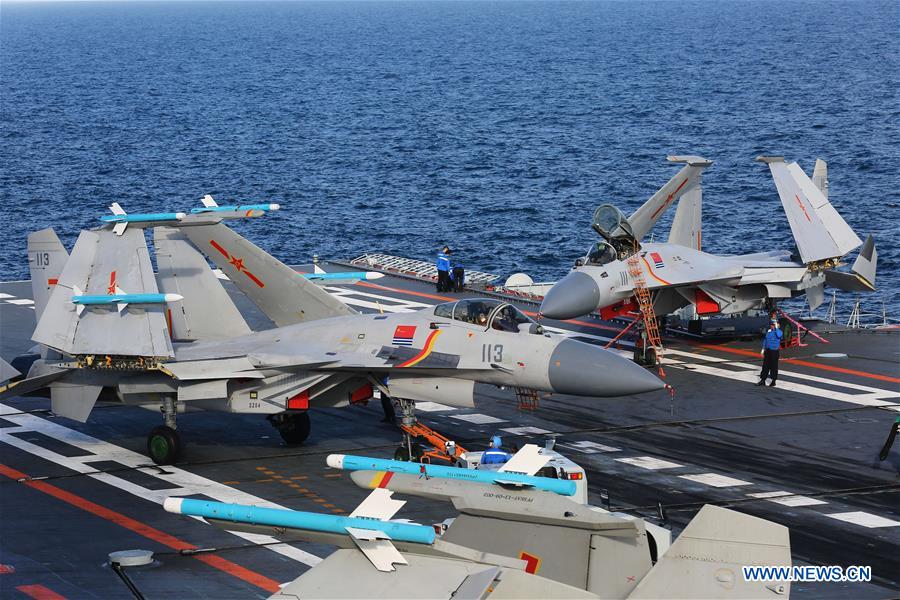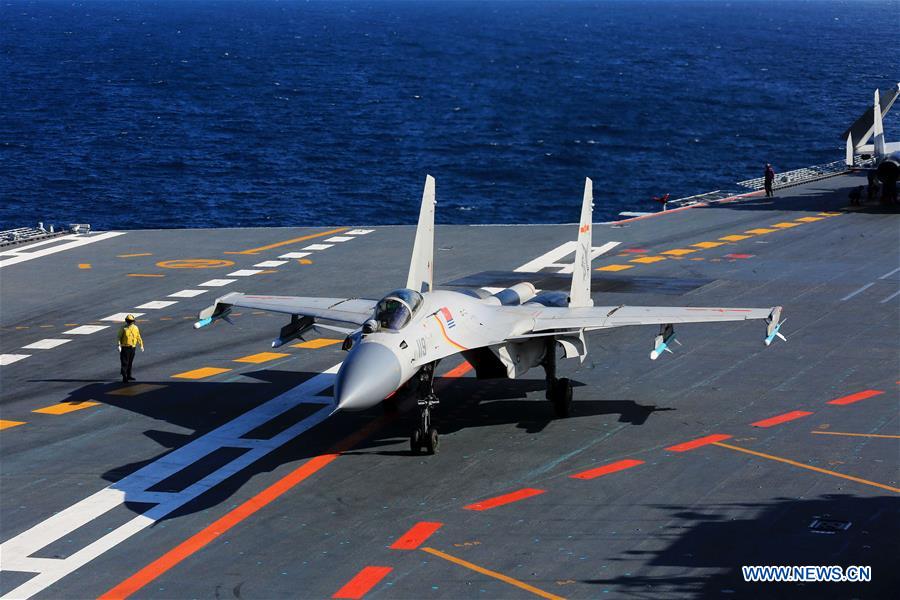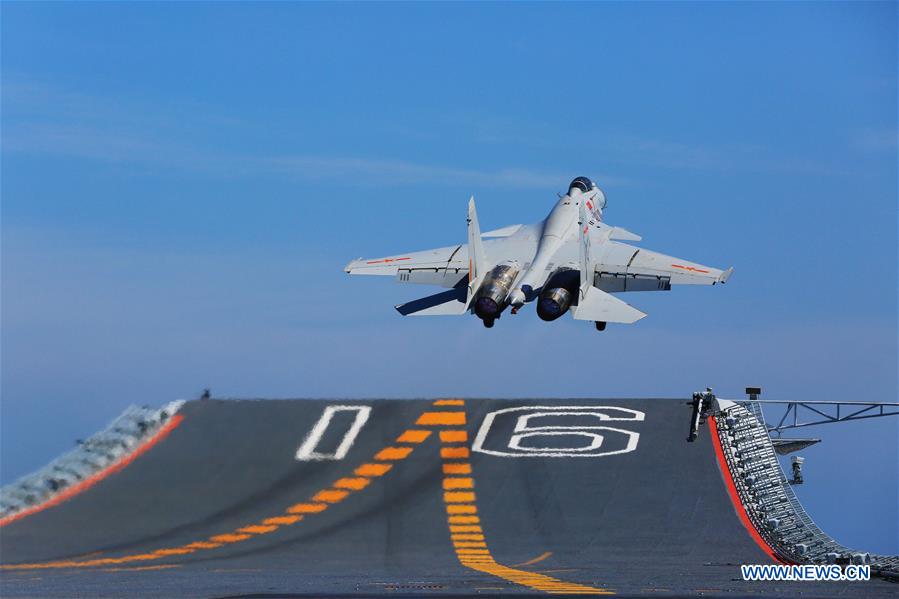You are using an out of date browser. It may not display this or other websites correctly.
You should upgrade or use an alternative browser.
You should upgrade or use an alternative browser.
PLA Navy news, pics and videos
- Thread starter Jeff Head
- Start date
Jura The idiot
General
now picking five out of eight from inside ofI'm guessing the most interesting part so far had been the July 1 drills I noticed Today at 6:29 PM
Chinese aircraft carrier formation conducts trans-regional training
Xinhua| 2017-07-03 12:39:21
:A flotilla including aircraft carrier Liaoning has been undertaking trans-regional training since it set out from east China's Qingdao on June 25.
The naval formation includes destroyers Jinan and Yinchuan, frigate Yantai, and a squadron of J-15 fighter jets and helicopters.
This training mission, like previous ones, is expected to strengthen coordination among the vessels and improve the skills of crew and pilots in different marine regions.
The formation will visit Hong Kong Special Administrative Region (HKSAR) in early July to celebrate the 20th anniversary of the (PLA) being stationed in HKSAR, Liang Yang, spokesperson for the PLA Navy, said Sunday.
Officers and soldiers will attend various exchanges and activities with Hong Kong residents and the PLA Garrison in the HKSAR, and the warships will be open for the public to visit, Liang said.





Jura The idiot
General
now noticed about closer to me than to China (I know it says "in late July" but still):
China and Russia’s Joint Sea 2017 Baltic Naval Exercise Highlight a New Normal in Europe
China and Russia’s Joint Sea 2017 Baltic Naval Exercise Highlight a New Normal in Europe
it's USNI NewsChina and Russia planned exercise in the Baltic Sea is raising eyebrows in northern Europe, NATO headquarters and Washington.
Dubbed Joint Sea 2017, the China-Russia maritime exercise in late July will see the introduction of a People’s Liberation Army Navy destroyer, frigate, and a support ship into the Baltic Sea. The PLAN flotilla will join Russia’s Baltic Sea fleet off St. Petersburg for joint drills. Joint Sea 2017 follows on the heels of the latest iteration of BALTOPs, a U.S. Navy Europe-led annual exercise that in mid-June brought together some fifty ships and fifty aircraft — including a B-52 and a B-1 — from the U.S., Germany, Denmark, the Netherlands, the United Kingdom and other allied navies.
The two-week naval exercise focused on high-end maritime warfighting drills in a corner of Europe that has been tense ever since Russia’s annexation of Crimea in 2014. The Baltic Sea has also been a space for close encounters between Russia and the United States over the last few years, both in the air and maritime domains. USS Donald Cook was repeatedly buzzed by Russian jets while operating in the Baltic Sea in 2016, and U.S. reconnaissance flights over the Baltic have repeatedly encountered Russian interceptions, with the Russian jets performing close maneuvers and showing off their weapons load outs by turning the underside of their wings towards the U.S. aircraft.
Amidst the tension, Joint Sea 2017 has caused consternation in northern Europe, and generated speculations about whether yet another great power is seeking to insert itself into an already on-edge region.
The exercise in the Baltic may be seen as a subtle signal of Chinese support for Russia’s efforts to reshape the European security order; in a fashion not unlike the one being used by China in the South China Sea dispute. But the Chinese presence in the Baltic Sea for a joint exercise with Russia is not necessarily connected to the ongoing contest between a US-led NATO and a revanchist Russia.
Instead, the Chinese presence in the Baltic Sea could be seen as forming part of China’s growing sense of global interests. And this is not the first time that the PLAN turns up in European, or even northern, waters.
In May of 2015 Chinese warships conducted exercises with the Russian Black Sea fleet in both the Mediterranean and the Black Sea, and later the same year a small flotilla of Chinese ships passed through the Kiel Canal for the first time on their way to port visits in Poland, Finland and Denmark. Chinese warships on counter-piracy patrols off the Horn of Africa have also entered the Mediterranean from time to time to make port calls in Greece, Italy, and Spain. But China’s maritime presence around Europe has not only been about port visits and exercises; in 2011 the PLAN, while in the Mediterranean, directed a major non-combatant evacuation of Chinese citizens from Libya ahead of the uprising and air campaign that felled the Muammar Gaddafi regime.
The Baltic is not unimportant to China and Beijing is eager to ensure that its ships have access to the global maritime domain. The Baltic Sea provides an outlet to the North Sea and the broader North Atlantic for northern and eastern Europe and some 10,000-cargo ships transit the Baltic on an annual basis. If the Russian vision of an Asia-Europe shipping route across the Arctic ever becomes reality the Baltic would provide convenient access to ports and markets in northern Europe. And while China’s interests in Europe and the maritime domains around the continent may be primarily commercial in nature, economic linkages tend to attract a naval presence as well. And naval power has a diplomatic quality to it, which is being used to forge ties when Chinese ships call in ports around the Baltic Sea and the Mediterranean.
China’s maritime focus will surely remain on the South China Sea and the Pacific for the foreseeable future, but the occasional presence of Chinese warships in European seas will likely be part of a new normal. It is yet another sign of how the world is increasingly competitive and contested, including in the maritime domain.
Jura The idiot
General
now noticed
(automatically translated) "1 destroyer Type 052C, 1 frigate Type 054 A and 1 Type 903 A of the Chinese Navy tanker came into Mediterranean July 6."

sure looks like a Suez Canal ... pennant number 150 would belong to "Changchun"
(automatically translated) "1 destroyer Type 052C, 1 frigate Type 054 A and 1 Type 903 A of the Chinese Navy tanker came into Mediterranean July 6."

sure looks like a Suez Canal ... pennant number 150 would belong to "Changchun"
Yes, I've watched the entire video and can confirm the content with only a minor adjustment on the time line. The last milestone will be earlier than 2019 according to Ma's estimation. So far as to translation, what kind of it do you prefer? Word-by-word or in landscape?This allegedly is a documentary on the breakthroughs in EMAL, all-electric propulsion, and EM railgun . Can anyone confirm and translate this? Does anyone have a link to the video?




by78
General
Yes, I've watched the entire video and can confirm the content with only a minor adjustment on the time line. The last milestone will be earlier than 2019 according to Ma's estimation. So far as to translation, what kind of it do you prefer? Word-by-word or in landscape?
A summary would be great... AND could you give a link to the video? Please please. Thanks!
Jura The idiot
General
I second thatA summary would be great... AND could you give a link to the video? Please please. Thanks!






